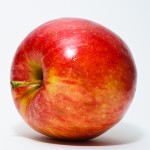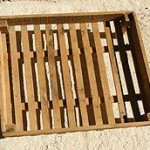by Cat, Sept 2007; updated 2012 (Photo, right, fromWikipedia)
Apples are probably my favorite fruit – or at least the one I consume the most consistently. I have a Macintosh apple tree in my small orchard, that my Mom planted in the early 1970s – Macs are the most common apple where I live. And in 2012, I planted a young honeycrisp tree, my new favorite because the apples keep through the winter in my root cellar.
I put half an apple in my morning smoothie (or 1/3 if the apple is large), and I eat the other half with my lunch. I really do believe that an apple a day keeps the doc away. Most health practitioners acclaim the level of antioxidants in the apple, but for me, I think its the natural pectin fiber that really helps me.
Apples can be cooked, baked, juiced, and eaten raw. You get the most benefit from the apple when eaten whole and raw.
Includes: 1. Health benefits of apples; 2. Which varieties are best for….; 3. The Apple Table; 4. Winter storage of apples
Health Benefits of Apples
Apples are rich in polyphenols (especially in the peel), quercetin being the most well known. Polyphenols are a category of anti-oxidants that protect your body from inflammation and other problems.
Apples also play an important role in blood sugar regulation and insulin sensitivity, and may help stave off Type-2 Diabetes. Eden’s fruit also has anti-cancer benefits and helps with decreased risk of asthma issues.
See World Healthiest Foods: Apples (6) and Mercola: What Are the Amazing Health Benefits of Apples? (7) for lots more info.
Which Varieties are Best For….
“Not all apples are created equal.” Some are best for snacking, others for cooking or baking. Refer to table below. (Info from Good Housekeeping magazine (1) and Purdue University Cooperative Extension Service (2)).
The Apple Table:
KEY: N/A = Not Available; E = Excellent, G = Good, F = Fair, N = Not Recommended; also indicates number of months each variety will last in cold storage. 
NOTE: certain pear varieties can also be stored for the winter, including comice and D’anjou, but for a shorter period of time than apples. I can’t find info on storage of bosc, but I suspect they also can be stored.
Winter Storage of Apples
Apples keep best in a cold area, 300 – 320F, with 90% relative humidity and some air circulation. To keep the humidity up, you can cover your storage containers with a sheet of plastic. When daytime temps are well above 320F, and night temps fall below 320F, ensure that your above-ground storage area has adequate ventilation during the hours of darkness (not applicable to root cellars/root boxes). Best to have vents near the ground for entry of cold night air, and near the top for exit of warm air.
Refer to the table above, and also the following websites for information on storing apples for the winter:
Backwoods Home Magazine (3) or Associated Content (4): select only blemish-free apples of thicker-skinned varieties, wrap in tissue or newspaper, twist corners to secure apple, then store in box with lid (not necessarily air-tight) in an unheated garage, enclosed back porch, unheated attic, root box or root cellar.
Purdue University Cooperative Extension Service (2): For small quantities, store in perforated plastic bags. For larger quantities, store in cardboard or wooden boxes, and insulate with sawdust or straw.
French Gardening.com (5): Store in cageot à fruits: special wood, wicker or twig baskets in which apples are laid in a single layer; the baskets are stacked and stored in a cool place (photo, right, from FrenchGardening.com (5)).
I store my apples in cardboard boxes: I wrap each apple in newspaper, and arrange in a single layer in the box. Then I put several sheets of newspaper on top of the layer, and then add another layer of wrapped apples. Total of 3 layers in one box, but ideally there should only be one layer so the air can circulate better.
References:
Some of these are from older versions of the respective websites; they attempt to redirect you to the current site, but some fail.
- Good Housekeeping, October 2007
- Home Storage of Apples: ag.purdue.edu/hla/pubs/HO/HO-95.pdf
- backwoodshome.com/here-are-some-simple-tips-on-how-to-store-apples-for-a-long-long-time/
- Associated Content: their page is no longer available – goes to Yahoo’s error page
associatedcontent.com/article/32205/protect_apples_for_longterm_storage.html


